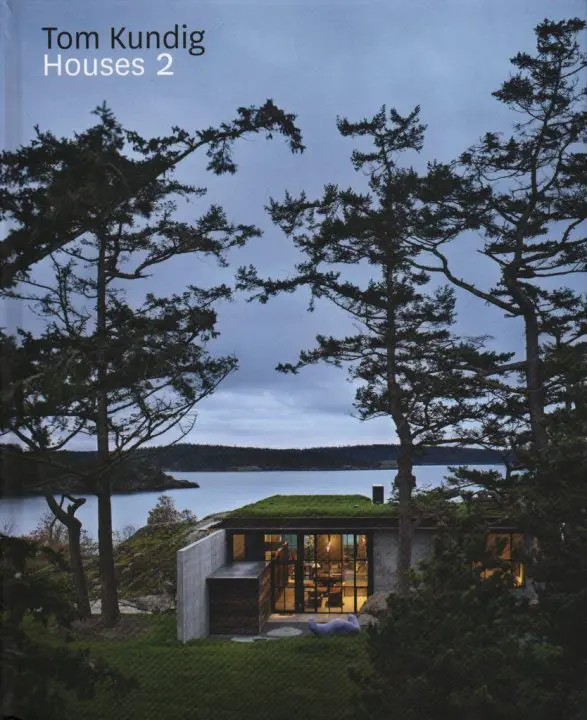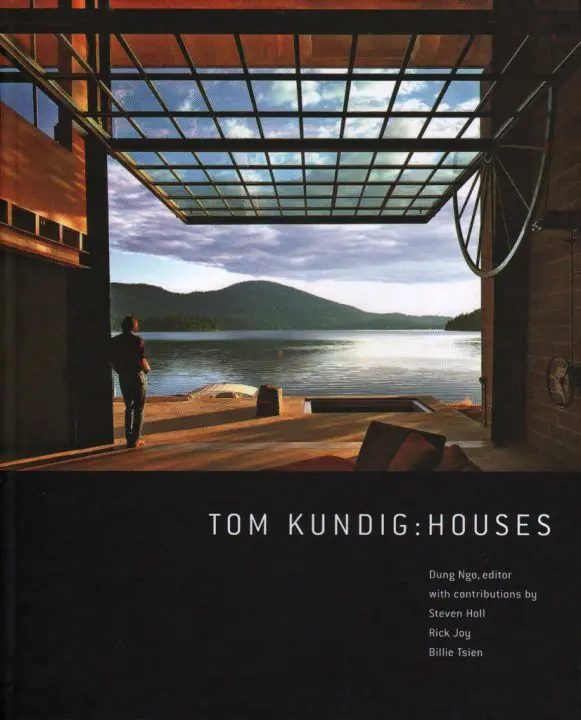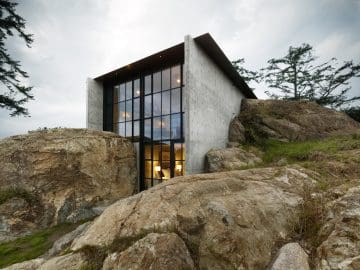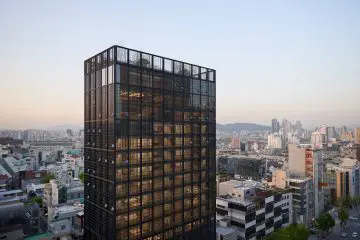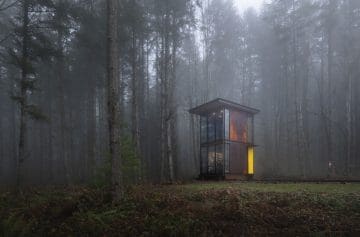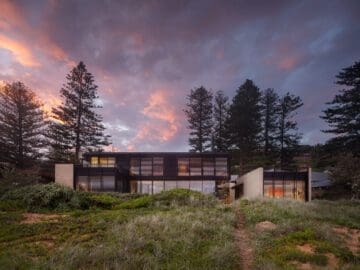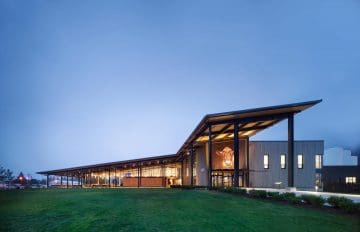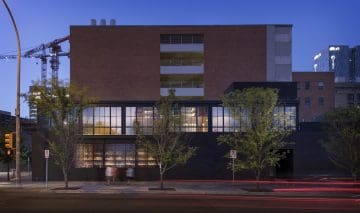Tom Kundig, FAIA, RIBA, has spent over four decades crafting award-winning architecture across six continents. He finds joy in the grit and determination needed to innovate, creating functional architecture that responds to context and reflects the stories of its users. After years of honing his distinctive style, Tom became a principal and owner of Olson Kundig in 1996. His portfolio spans a range of built and ongoing projects, from adaptive reuse developments and hospitality destinations to sports facilities and venues, museums, wineries, private homes, and more.

Architecture is evolutionary—not revolutionary.
Tom Kundig
Principal / Owner & Founder | FAIA, RIBA
Elemental Experimentation
Tom’s architecture is driven by a longstanding curiosity in the interaction between people and their environments. He approaches each project with an elemental understanding of the physics of movement—both human and tectonic—materiality, and detail, creating architecture that is approachable and deferential to its surroundings. This holistic approach considers the full range of project tectonics, producing architecture that is quietly powerful and profoundly human.


You’re not trying to compete with the landscape, you’re trying to find where the architecture belongs within that landscape, whether you’re building in the rural landscape or a big city.Tom Kundig, FAIA, RIBA
Principal / Owner & Founder


Despite the evolving scope and complexity of his work, Tom continues to return to small projects, which serve as laboratories for research and experimentation. These intimate, agile projects allow him to distill materiality and tectonics to their core, testing, iterating, and refining concepts. Incorporating the expertise of artists, craftspeople, engineers, and other collaborators, Tom leverages this knowledge to challenge design conventions, pushing his work to constantly evolve. His projects are innovative while responsive to their context, whether a private home or a high-tech research facility.

Homes and small projects are like little jazz moments—you can experiment, you can play. You’re getting close to the meaning of being human. Everything on a small project is so contextually based: it’s the client, the landscape, the program, the budget, the materials. It’s the tectonicsTom Kundig, FAIA, RIBA
Principal / Owner & Founder

Responsive Design
Tom’s work often integrates kinetic design, sometimes referred to as gizmos. These simple machines engage the human body to create dynamic architecture. Here, the human body plays a crucial role, physically acting upon the machine to make spaces move and morph to adapt to changing user needs. Each kinetic element frames an elegant, straight-forward solution to a specific design challenge.
Custom-designed for specific site conditions, these mechanisms can make small spaces expansive, connect separate zones, and blur the threshold between indoors and outdoors. They encourage people to attune to their evolving needs and become more aware of their impact, fostering a deeper connection to the environment.

The work of Tom Kundig takes your hand and says, ‘Stop for a moment and be aware of what you are doing and where you are.'Billie Tsien
Awards & Recognition
Tom has been recognized by over 230 individual and project awards. He is one of the American Institute of Architects’ (AIA) most distinguished members, receiving over 80 local, regional, and national awards. At the national level, his work has been honored with 10 National Honor Architecture Awards (Studhorse, Martin’s Lane Winery, and Wagner Education Center at the Center for Wooden Boats, among others), National Housing Awards (Delta Shelter, Outpost, and Sol Duc Cabin, among others), National Interior Architecture Awards (The Pierre and Charles Smith Wines Tasting Room & World Headquarters), Small Project Awards (Costa Rica Treehouse and Sawmill), and two COTE Top Ten Awards (Sawmill and Wagner Education Center at the Center for Wooden Boats). Juries have noted his work is, “Elegant in its simplicity,” and remarked, “This is a ‘wish you had done it’ project.”
Individually, he has received a National Design Award in Architecture from the Cooper Hewitt Smithsonian Design Museum, an Academy Award in Architecture from the American Academy of Arts and Letters, election to the National Academy as an Academician in Architecture, and the AIA Seattle Gold Medal. Wallpaper* 400 has also named him a “tastemaker” defining America’s creative landscape.
Under his leadership, Olson Kundig won the 2009 National AIA Architecture Firm Award and has been named one of the Top Ten Most Innovative Companies in Architecture four times by Fast Company. The firm has been featured 16 times on Architectural Digest’s AD100 list, honoring top international talent in architecture and design.

Influence
Tom expands the conversation around design through books, interviews, and publications, reaching a broad audience beyond the profession. His work and perspectives are published in four monographs: Tom Kundig: Houses (2006) and Tom Kundig: Houses 2 (2011), which are Princeton Architectural Press’s best-selling architecture books of all time, with over 36,000 copies sold; Tom Kundig: Works (2015) reprinted three times; and Tom Kundig: Working Title (2020). A fifth monograph will be published by Monacelli Press in 2025.
His work has been widely published in outlets like The New York Times, ARCHITECT, Architectural Record, Architectural Digest, Hauser, The Plan, and Wallpaper*, among others. Additionally, Tom’s projects also appear in architecture books from leading publishers, including Phaidon, Monacelli, Thames and Hudson, Simon & Schuster, and Taschen.

Design Leadership
Tom engages with both live and digital audiences worldwide, serving on juries for the AIA, Dezeen, and Architizer A+ award programs, among others. He frequently speaks at colleges, universities, industry events, and on podcasts, including the AIA National Convention, AIA Custom Residential Architects Network (CRAN) Symposium, Nike’s Guest Speaker Series, US Modernism podcast, Time Sensitive podcast, the Burke Museum, and the Telluride Art + Architecture Festival.
Previously, Tom has been a studio critic at Harvard University, the University of Oregon in Kyoto, and the University of Arkansas. He has also held positions as the D. Kenneth Sargent Visiting Design Critic at Syracuse University and the Jon Adams Jerde Chair in Architecture at USC. His award-winning designs have been exhibited at the American Academy of Arts and Letters, the Istanbul Design Biennial, Syracuse University, the National Building Museum, and the TOTO GALLERY MA in Tokyo.

In mountain climbing, it’s not about getting to the top; it’s about how you get to the top. It’s the elegance, the efficiency, the time, the skills. Developing that kind of discipline has followed me through my architecture.Tom Kundig, FAIA, RIBA
Principal / Owner & Founder


I want to actively engage the craftsperson, the maker, the builder, because they’re making a physical thing out of the thing I drew, and learning about their process improves the way I think about design and impacts how I draw the next thing.Tom Kundig, FAIA, RIBA
Principal / Owner & Founder





Gizmos blend functionality and poetry. They make you think more deeply about how you take up space, which in turn promotes a sense of stewardship for that space. I’ve completed numerous gizmos and continue to experiment with Olson Kundig’s gizmo expert, Phil Turner.Tom Kundig, FAIA, RIBA
Principal / Owner & Founder



Tom on Play
Visit Play to dig deeper into stories from Olson Kundig projects and people, including recorded interviews, design features, site visits, Speaker Series presentations, and more!
Projects
Lectures & Juries
2024
Georgia Tech | One Building Symposium, Presenter
National Academy of Design | 2024 Annual Exhibition
Auburn University | Bob + Sherry Faust Distinguished Lecture, Lecturer
Interior Design | Giants + Rising Talent Conference, Panelist
2023
AIA Chicago Design Excellence Awards, Juror
Archipro Commercial Expo, Speaker
Long Arc Capital Speaker Series, Speaker
Council on Tall Buildings and Urban Habitat, Americas Regional Conference, Closing Keynote Speaker
AIA Cultural Facilities Committee, Arthur M. Rosenblatt Memorial Lecture on Museum Design, Speaker
AIA Cran Symposium, Speaker
2022
Dezeen Awards, Juror
AIA Pennsylvania Awards, Jury Chair
AIA Los Angeles Awards, Juror
AIA Committee on the Environment Top Ten for Students Competition, Juror
Telluride Arts, Art + Architecture Festival, Speaker
AIA Wisconsin Convention, Keynote Speaker
Rainier Club, the Burke Museum, Presentation
Telluride Forever, Speaker
University of Miami School of Architecture, Guest Lecture
2021
Architizer A+ Award, Juror
Auberge / Goldener Hirsch Hotel, Launch Event Speaker
AIA Seattle Committee on Architecture for Education, the Burke Museum, Speaker and Tour Guide\
Telluride Arts District Talk, Speaker
Nike Guest Speaker Series, Presentation
Brick & Wonder / Financial Times, “Building Your Dream Home,” Panelist
National Academy of Design, Virtual Exhibition, Contributor
2020
University of Washington, “Architecture Conversations,” Speaker
Glass House Talk With Pilar Viladas, Speaker
The Burke Museum Gala, Speaker
2019
AIA Western Mountain Region Design Awards, Juror
AIA National Convention, “2+2: Achieving Outstanding Design,” Panelist
The Glass House, “Tom Kundig + Mark Rizzo,” Panelist
Bernard Zimmerman Lecture Series, California State Polytechnic University, Guest Lecturer
Royal Academy of Arts, “Tom Kundig in Conversation,” Panelist
National Academy of Design Exhibition at the Core Club, Exhibitor
Seattle Design Commission Tour of the Wagner Education Center at the Center for Wooden Boats, Speaker
University of Washington President’s Homecoming Pre-game Reception, Speaker
Press Preview, the Burke Museum, Speaker
“Buy-In” Event, the Burke Museum, Speaker
2018
Architizer A+ Awards, Juror
AIA National Convention, “Cocktails and Conversations,” Panelist
Rural Studio Commencement Speaker
2017
AIA New York Honor Awards, Juror
Architizer A+ Awards, Juror
AIA New York, “Cocktails and Conversations,” Panelist
Construction Specifications Institute Prospec, Speaker
Dallas Architecture Forum, “Design Symposium: Material Design,” Panelist
2016
Arch Out Loud’s Last House on Mulholland Competition, Juror
Architizer A+ Awards, Juror
Home Magazine’s Home of the Year, Juror
AIA Charleston + cac.c Lecture Series, “Tom Kundig: Works,” Lecturer
Royal College of Art, “The Rise of the Maker Architect: From Hot-Rodding to Resilience,” Keynote Speaker
2015
Los Angeles AIA Design Awards, Juror
Eleven Magazine’s Cambodia 2015 Design Challenge, Juror
University of Southern California, School of Architecture, Jon Adams Jerde, Faia Chair in Architecture and Visiting Professor
AIA National Conference, “Urban Sketching,” Panelist
The Barnes Museum, Lecturer
Texas Society of Architects, Design Conference, “Craft,” Lecturer
Dallas Architectural Forum, Lecturer
University of Texas at Arlington, School of Architecture, Lecturer
Hallstatt Technical College, Lecturer
AIA Louisiana, “Celebrate Architecture—Baton Rouge,” Panelist
2014
Cooper-Hewitt National Design Awards, Juror
Iowa State University, Herbert Lecture in Architecture, Keynote Speaker
Tulane School of Architecture, Lecturer
Nevada Museum of Art, “Dice 2014: Craft,” Lecturer
Los Altos Neutra House, Architecture and Design Series, Keynote Speaker
2013
Western Living Awards, Juror
George Matsumoto Prize, Juror
Architizer A+ Awards, Juror
AIA Western Mountain Region Conference, “Landscape, Community, Craft,” Keynote Speaker
University of Southern California, Faia Chair in Architecture, Keynote Speaker
Starbucks Headquarters, Global Design Innovation Summit, Lecturer
Alaska Design Forum, “Here: From Global to Hyper Local,” Lecturer
Northwest Museum of Arts and Culture, AIA Spokane Visiting Lecture Series, Lecturer
Stanford University, “Architecture & Landscape,” Lecturer
The Project Room, “Successful People Talking About Failure,” Lecturer
2012
Cement Concrete & Aggregates Australia, “C+a Talks,” Lecturer
2011
Lyceum Fellowship, Juror
Arizona State University, Visiting Design Critic
Royal Academy of Arts, London, “Landscape, Community and Craft,” Lecturer
Ghost 13 International Architecture Conference, “Tom Kundig: Craft/Context/Hot Rodding,” Lecturer
University of Washington, College of Built Environments, “Landscape, Community and Craft,” Lecturer
2010
Maine AIA Design Awards, Jury Chair
AIA Committee on Architecture for Education (Cae) Awards, Juror
University of Arkansas, John G. Williams Distinguished Professor
North Carolina State University School of Architecture/AIA Triangle Chapter Joint Lecture Series, “Sacred Place,” Lecturer
University of Arkansas, Lecturer
San Antonio AIA Lecture Series, Speaker
University of Texas, Austin, Lecturer
2009
AIA San Francisco Design Awards, Juror
Lyceum Fellowship, Jury Chair
Architectural Record Advertising Excellence Awards, Juror
National Building Museum, Spotlight on Design, Lecturer
University of Washington, Dean’s Distinguished Lecture, Lecturer
Arts Council of Sonoma County, North X North Coast Lecture Series, Lecturer
Architalx Lecture Series, Lecturer
Street of Eames, Lecturer
The Back Room Lectures, Panelist
Seattle Art Museum and Cascade Land Conservancy, “Art, Design & Sustainability: A Dialogue,” Panelist
2008
AIA East Bay, Juror
University of Arizona, Lecturer
Washington University in St. Louis, Lecturer
2007
AIA San Antonio, Juror
University of Florida, Lecturer
Oklahoma State University, Lecturer
Arizona State University, Lecturer
2006
AIA National Honor Awards, Juror
AIA Western Mountain Region Honor Awards, Juror
Syracuse University, College of Architecture, D. Kenneth Sargent Visiting Design Critic
AIA National Convention, “Opening Details: Accessible Transition Between Inside and Out,” Panelist
AIA National Convention, “Architects Discuss America’s New Regionalism,” Panelist Residential Architect, Reinvention Conference, Keynote Speaker
University of Illinois at Urbana-Champaign, Lecturer
University of Washington, Lecturer
2005
AIA Wisconsin Honor Awards, Juror
Western Interiors & Design Conference, Lecturer
Cooper Hewitt, Smithsonian Design Museum, Lecturer
University of Washington, College of Architecture and Urban Planning, “New Wave of Structural Engineering in Architecture,” Panelist
Sun Valley Center for the Arts, Lecturer
AIA Louisiana, “Celebrate Architecture—Baton Rouge,” Panelist
American Federation of the Arts, “Restructure: New Form in Architectural Mesh,” Panelist
2004
AIA Portland Honor Awards, Juror
Texas Tech University, Visiting Design Critic
University of Oregon, Visiting Instructor in Kyoto, Japan
AIA Seattle, “Fellows Series: Tom Kundig, Faia,” Lecturer
Architectural League of New York, “Emerging Architect,” Lecturer
Winston Wachter Gallery, “The Intersection Between Art, Design & Architecture,” Panelist
National Building Museum, “Liquid Stone Exhibit,” Lecturer
Portland State University, College of Architecture, “Tom Kundig: Work,” Lecturer
2003
AIA Nebraska Honor Awards, Juror
Harvard University Gsd Seminar, Lecturer
Art Basel/Miami Beach, “Architecture for Art: Collecting, Conserving and Exhibiting,” Moderator
Western Interiors Design Conference, Lecturer
AIA New York City & Bulthaup Lecture Series, “Designing Around an Art Collection,” Lecturer
2002
AIA Idaho Honor Awards, Juror
AIA Eastern Washington Awards, Juror
AIA Northwest & Pacific Region Conference, Panelist
2001
AIA NW Washington Awards, Juror
University of Oregon, Visiting Design Critic in Kyoto, Japan
Architectural Institute of British Columbia, Exhibit, Lecturer
2000
University of Oregon Architectural Lecture Series, Lecturer
1999
Washington State University, Visiting Design Critic
University of Washington, Graduate Design Studio, Instructor
1997
Pilchuck Glass School, Lecturer
Spokane Art School, Lecturer
Education
Master of Architecture, University of Washington
Bachelor of Arts in Environmental Design, University of Washington, Magna Cum Laude
Awards
2025
AIA COTE Top Ten Award, Wagner Education Center at The Center for Wooden Boats
AIA Housing Award, Manhattan Beach Residence
Architectural Digest’s AD100 list, Olson Kundig
2024
AIA California Design Awards, Award of Merit, Aro Homes
AIA National Honor Award – Architecture, Wagner Education Center at The Center for Wooden Boats
Architectural Digest’s AD100 list, Olson Kundig
Ocean Home Magazine, Top 50 Coastal Architects, Olson Kundig
2023
AIA National Small Project Award, Costa Rica Treehouse
AIA Los Angeles Residential Design Awards, Adaptive Reuse/Renovation/Historic Preservation Honor Award, 8899 Beverly Boulevard
Chicago Athenaeum American Architecture Award, 8899 Beverly Boulevard
Chicago Athenaeum, American Architecture Award, Lebron James Center at Nike World Headquarters
LIV Hospitality Design Awards, Architecture – Living Space, Condominium Category Winner, 8899 Beverly Boulevard
LIV Hospitality Design Awards, Architecture – Living Space, North America Category Winner, 8899 Beverly Boulevard
LIV Hospitality Design Awards, Interior Design – Living Space, Condominium Category Winner, 8899 Beverly Boulevard
LIV Hospitality Design Awards, Interior Design – Living Space, North America Category Winner, 8899 Beverly Boulevard
LIV Hospitality Design Awards, Architecture – Eating Space, Restaurant – Casual Category Winner, Comedor Restaurant
LIV Hospitality Design Awards, Architecture – Eating Space, North America Category Winner, Comedor Restaurant
LIV Hospitality Design Awards, Interior Design – Eating Space, North America Category Winner, Comedor Restaurant
Architectural Digest, AD100 List, Olson Kundig
Mountain Living Magazine, Top Architects and Designers List, Olson Kundig
2022
AIA National Housing Award, Costa Rica Treehouse
AIA National Housing Award, Rio House
AIA Northwest and Pacific Region Honor Awards, Merit Award, LeBron James Innovation Center at Nike World Headquarters
World Architecture News Awards, Gold Medal, Civic – Libraries & Museums, The Burke Museum
World Interiors News Awards, Gold Medal, One-Off Homes – Large & Small Category, Bilgola Beach House
Chicago Athenaeum, American Architecture Awards, Comedor Restaurant
Interior Design Best of Year Awards Finalist, Sports/Fitness Office Category, LeBron James Innovation Center at Nike World Headquarters
Architectural Digest, AD100 List, Olson Kundig
AN Interior, Top 50 North American Architects Working In Interiors Today, Olson Kundig
Mountain Living Magazine, Top Architects and Designers List, Olson Kundig
Ocean Home Magazine, Top 50 Coastal Architects, Olson Kundig
2021
AIA National Honor Award – Architecture, Martin’s Lane Winery
AIA Northwest & Pacific Region Design Awards, Citation Award, Costa Rica Treehouse
AIA Northwest & Pacific Region Design Awards, Citation Award, Hale Lana
Architectural Digest, AD100 List, Olson Kundig
ENR Mountain States, Best Project, Residential/Hospitality, Residences at Goldener Hirsch
Gray Magazine Awards, Editor’s Pick, Comedor Restaurant
Master Builders Association of NSW Excellence in Housing Awards, Winner (Contract Houses, $9 Million – $10 Million), Bilgola Beach House
Mountain Living Magazine, Top Architects and Designers List, Olson Kundig
Ocean Home Magazine, Top 50 Coastal Architects, Olson Kundig
2020
AIA Northwest and Pacific Region Design Awards, Honor Award, Rio House
AIA Northwest and Pacific Region Design Awards, Honor Award, The Burke Museum
AIA Seattle Honor Awards for Washington Architecture, Award of Honor, The Burke Museum
AIA Seattle Honor Awards for Washington Architecture, Award of Honor, Wagner Education Center at the Center for Wooden Boats
AIA Washington Council Civic Design Awards, Honor Award, The Burke Museum
FX International Interior Design Awards, Winner, Museum or Exhibition Space, The Burke Museum
Architect’s Newspaper Best of Design Awards, Honorable Mention, Cultural, The Burke Museum
Architect’s Newspaper Best of Design Awards, Honorable Mention, Commercial Hospitality, Comedor Restaurant
Gray Magazine Awards, Pacific Northwest Best of Show, The Burke Museum
Architectural Digest, AD100 List, Olson Kundig
Architectural Record, Record House, Rio House
Fast Company, World’s Most Innovative Companies List, Olson Kundig
SMPS Seattle Reign Awards, Best Website, Olson Kundig
2019
AIA Northwest and Pacific Region Design Awards, Merit Award, 100 Stewart Hotel & Apartments
AIA Northwest and Pacific Region Design Awards, Merit Award, Wagner Education Center at the Center for Wooden Boats
AIA Washington Council Civic Design Awards, Honor Award, Wagner Education Center at the Center for Wooden Boats
ARCHITECT Magazine, Architect 50 List, Olson Kundig
Architectural Digest, AD100 List, Olson Kundig
Eater Austin Awards, Design of the Year, Comedor Restaurant
Fast Company, World’s Most Innovative Companies List, Olson Kundig
Ocean Home Top 50 Coastal Architects, Olson Kundig
Seattle Daily Journal of Commerce, Building of the Year Finalist, The Burke Museum
Seattle Daily Journal of Commerce, Building of the Year Finalist, Wagner Education Center at the Center for Wooden Boats
SEGD Global Design Awards Finalist, Tillamook Creamery
Wallpaper* Design Awards, Best New Private House Shortlist, Costa Rica Treehouse
2018
AIA Committee on the Environment Top Ten Award, Sawmill
AIA National Small Project Award, Sawmill
AIA Seattle Honor Awards, Honor Award, Sawmill
Chicago Athenaeum, American Architecture Award, 100 Stewart Hotel & Apartments
Chicago Athenaeum, American Architecture Award, Sawmill
2017
AIA National Honor Awards, Housing, Sawmill
AIA Northwest & Pacific Region Honor Awards, Citation, Martin’s Lane
AIA Northwest & Pacific Region Honor Awards, Citation, Sawmill
Architectural Digest, AD100 List, Olson Kundig
Architectural Record Awards, Record House, Meg Home
Architectural Record, Top 300 Firms List, Olson Kundig
Chicago Athenaeum, American Architecture Award, Charles Smith Winery Jet City
Chicago Athenaeum, American Architecture Award, Martin’s Lane Winery
Chicago Athenaeum, American Architecture Award, Sawmill
Chicago Athenaeum, American Architecture Award, Shinsegae International
Gray Magazine Awards, Winner – Wild Card Category, Olson Kundig
Historic Seattle Preservation Awards, Best Neighborhood Reinvestment, Optimism Brewery
World Architecture News, Tall Building Award, Shinsegae International
2016
AIA Northwest and Pacific Region Honor Awards, Honor Award, Shinsegae International
AIA Seattle Honor Awards, Honor Award, Martin’s Lane Winery
Architectural Digest, AD100 List, Olson Kundig
Architectural Record, Top 300 Firms List, Olson Kundig
Architizer A+ Awards, Jury Winner, Commercial: Office – Mid Rise (5-15 Floors), Shinsegae International
Architizer A+ Popular Choice Awards, Winner, Details: Architecture + Facades, 242 State Street
Architizer A+ Awards, Winner, Hospitality: Bars & Nightclubs, Charles Smith Wines Jet City
Architizer A+ Awards, Winner, Building Products: Hardware, The Tom Kundig Collection
Chicago Athenaeum, American Architecture Award, Pole Pass
CTBUH: Best Tall Building Awards, Finalist, Best Tall Building Asia & Australia, Shinsegae International
Historic Seattle Preservation Awards, Outstanding Modern Masterpiece, Dowell Residence
NAIOP Hospitality Development of the Year, 100 Stewart Street Hotel and Apartments
National Academy of Design, Inductee, Tom Kundig
Ocean Home Top 50 Coastal Architects, Olson Kundig
SMPS Seattle Reign Awards, Judge’s Choice, Tom Kundig: Works
The Plan Awards, Renovation, Honorable Mention, Dowell Residence
2015
AIA National Honor Awards, Housing, Studhorse
AIA Seattle Honor Awards, Honor Award, Shinsegae International
AIA Washington Civic Design Awards, Merit Award, Tacoma Art Museum Haub Galleries
Architectural Digest, AD100
Architizer A+ Awards, Finalist, The Tom Kundig Collection
2014
AIA National Honor Awards, Architecture, The Pierre
AIA National Honor Awards, Interior Architecture, The Pierre
AIA National Honor Awards, Housing, Sol Duc Cabin
AIA Northwest and Pacific Region Honor Awards, Citation Award, 242 State Street
ARCHITECT Magazine, Architect 50 List, Olson Kundig
Architectural Digest, AD100 List, Olson Kundig
Interior Design Best of Year Awards, Finalist, 242 State Street
2013
AIA National Honor Awards, Architecture, Art Stable
AIA National Honor Awards, Interior Architecture, Charles Smith Wines Tasting Room & World Headquarters
Architizer A+ Popular Choice Awards, Finalist, Residential Single Family Home, The Pierre
Architizer A+ Popular Choice Awards, Special Mention for Retail, Charles Smith Wines Tasting Room & World Headquarters
Architizer A+ Popular Choice Awards, Finalist, Residential Mid Rise (5-15 floors), Art Stable
Chicago Athenaeum, American Architecture Award, Charles Smith Wines Tasting Room & World Headquarters
Residential Architect Design Awards, Grand Award: Custom Home / More Than 3,000 SF, Studio Sitges
World Interiors News Awards, Interior Accessories Finalist, The Tom Kundig Collection
2012
AIA National Honor Awards, Housing, The Pierre
AIA Northwest and Pacific Region Honor Awards, Honor Award, The Pierre
AIA Seattle Honor Awards, Honor Award, The Pierre
AIA Seattle Honor Awards, Commendation Award, Tansu House
AIA Seattle Honor Awards, Citation Award, Shadowboxx Bathhouse
AIA Seattle Honor Awards, Commendation Award, Charles Smith Wines Tasting Room & World Headquarters
Architectural Digest, AD100 List, Olson Kundig
Builder’s Choice Design & Planning Awards, Builder’s Choice Grand Award, The Pierre
Builder’s Choice Design & Planning Awards, Builder’s Choice Special Focus, Shadowboxx Bathhouse
Chicago Athenaeum, American Architecture Award, Studio Sitges
Chicago Athenaeum, American Architecture Award, The Pierre
European Centre and Chicago Athenaeum International Architecture Award, Art Stable
IIDA Interior Design Awards, Best of Competition, The Pierre
IIDA Northern Pacific Chapter INawards, People’s Choice Award, Charles Smith Wines Tasting Room & World Headquarters
Interior Design Magazine Hall of Fame, Inductee, Tom Kundig
Interior Design Magazine Best of Year Awards, Best of Year, Tom Kundig Collection
National Society for Marketing Professional Services Awards, 3rd Place: Book/Monograph, Tom Kundig: Houses 2
Residential Architect Design Award, Architectural Detail Merit Award, Shadowboxx Bathhouse
Residential Architect Design Award, Architectural Detail Merit Award, Studio Sitges Front Door
Washington Main Street Program Awards, Outstanding Design or Rehabilitation Project Award, Charles Smith Wines Tasting Room & World Headquarters
2011
AIA National Honor Awards, Housing, Art Stable
AIA National Honor Awards, Housing, 1111 E. Pike
AIA Northwest and Pacific Region Honor Awards, Honor Award, Art Stable
AIA Seattle Honor Awards, Merit Award, Sol Duc Cabin
AIA Seattle Honor Awards, Honor Award, Art Stable
AIA Seattle and Northwest Home Magazine Home of the Month, Riley’s Cove Residence
NAIOP Washington State Chapter Night of the Stars Awards, Market Adaptation of the Year, Stadium Nissan of Seattle
Northwest Design Awards, First Place: Exotic Retreats, The Pierre
Residential Architect Design Awards, Project of the Year, Art Stable
Residential Architect Design Award, Grand Award, Slaughterhouse Beach House
The Wallpaper* 150, Tom Kundig
Washington Aggregates & Concrete Association, Excellence in Concrete Construction, The Pierre
2010
AIA National Honor Awards, Architecture, Outpost
AIA Seattle Honor Awards, Citation, Art Stable Hinge
AIA Seattle Honor Awards, Citation, T Bailey Offices
Architectural Digest, AD100 List, Olson Kundig
Fallingwater Cabin Design Competition, Finalist
Fast Company, World’s Most Innovative Companies List, Olson Kundig
IIDA Northern Pacific Chapter INawards, Winner in Class: Hospitality, Mistral Kitchen
IIDA Northern Pacific Chapter INAwards, Honorable Mention: Mass, Touchstone Offices
IIDA Northern Pacific Chapter INawards, Honorable Mention: Concept, Portland Hilltop Residence Fireplace Tools
Northwest Design Awards, First Place: Hospitality, Mistral Kitchen
Northwest Design Awards, Commercial category, Second Place, Touchstone Offices
Residential Architect Design Award, Merit Award, Montecito Residence
Residential Architect Design Award, Merit Award, Gulf Islands Cabin
World Architecture News, House of the Year, The Pierre
2009
AIA Architecture Firm Award, Olson Sundberg Kundig Allen Architects
AIA National Honor Awards, Housing, Montecito Residence
AIA National Honor Awards, Housing, Outpost
AIA Northwest and Pacific Region Honor Awards, Honor Award, Rolling Huts
AIA Northwest and Pacific Region Honor Awards, Merit Award, Tye River Cabin
Architectural Record, House of the Month, Montecito Residence
Chicago Athenaeum, American Architecture Award, Outpost
Chicago Athenaeum, American Architecture Award, Rolling Huts
Fast Company, World’s Most Innovative Companies List, Olson Kundig
Residential Architect Design Award, Grand Award, Outpost
Residential Architect Design Award, Grand Award, Rolling Huts
Sunset – AIA Western Homes Awards, Honorable Mention, Montecito Residence
Treehugger: Best of Green, Best Architect, Tom Kundig
2008
AIA National Honor Awards, Architecture, Delta Shelter
AIA Northwest and Pacific Region Honor Awards, Honor Award, Montecito Residence
AIA Northwest and Pacific Region Honor Awards, Merit Award, Outpost
Architectural Record Awards, Record House, Rolling Huts
Chicago Athenaeum, American Architecture Award, Montecito Residence
Northwest Design Awards, First Place, Montecito Residence
The Smithsonian Cooper-Hewitt National Design Museum, National Design Award in Architecture Design, Tom Kundig
Zweig A/E Marketing Excellence Awards, First Place: Website, Olson Kundig
2007
AIA National Honor Awards, Housing, Delta Shelter
AIA National Honor Awards, Housing, Tye River Cabin
AIA Northwest and Pacific Region Honor Awards, Honor Award, Delta Shelter
AIA Seattle Honor Awards, Merit Award, Outpost
AIA Seattle Honor Awards, Merit Award, Rolling Huts
AIA Seattle Honor Awards, Award of Commendation, Montecito Residence
Architectural Digest, AD100 List, Olson Kundig
American Academy of Arts & Letters Academy Awards, Academy Award in Architecture, Tom Kundig
Chicago Athenaeum, American Architecture Award, Delta Shelter
Chicago Athenaeum, American Architecture Award, Tye River Cabin
National Society for Marketing Professional Services Awards, Website Award, Olson Kundig
Residential Architect Grand Award, Artist’s Studio
2006
AIA Seattle Honor Awards, Merit Award, Delta Shelter
AIA Seattle Honor Awards, Merit Award, Tye River Cabin
Architectural Record Awards, Record House, Delta Shelter
IIDA Northern Pacific Chapter INawards, Honorable Mention, Artist’s Studio
Residential Architect Design Awards, Grand Award, Delta Shelter
Seattle Homes and Lifestyles Magazine, Seattle 100 List, Olson Kundig
The MacDowell Colony, Fellow
2005
IIDA Northern Pacific Chapter INawards, Olson Kundig Office
Metropolitan Home Design 100, North Seattle Residence
Residential Architect Design Awards, Grand Award, Chicken Point Cabin
The Smithsonian Cooper-Hewitt National Design Museum, Finalist – National Design Award for Architecture, Tom Kundig
2004
AIA National Honor Awards, Architecture, Chicken Point Cabin
AIA National Honor Awards, Architecture, The Brain
Chicago Athenaeum, American Architecture Award, Chicken Point Cabin
Architectural League of New York, Emerging Architect: Tom Kundig
Masonry Institute of Washington Award, Lake House
2003
AIA Northwest and Pacific Region Honor Awards, Honor Award, Chicken Point Cabin
2002
AIA Seattle Honor Awards, Honor Award, Chicken Point Cabin
2001
AIA Northwest and Pacific Region Honor Awards, Honor Award, The Brain
2000
AIA Seattle Honor Awards, Honor Award, The Brain
AIA Summit 2000 Western International Design Awards, Merit Award, Studio Sitges
1999
AIA Seattle Honor Awards, Conceptual Honor Award, The Brain
1998
AIA Northwest and Pacific Region Honor Awards, Honor Award, Studio House
1997
AIA Seattle Honor Awards, Merit Award, Studio House
AIA Seattle Honor Awards, Honor Award, City House
AIA National Honor Awards, Religious Architecture, (associate architect to Steven Holl), Chapel of St. Ignatius
AIA National Honor Award, Architecture, (associate architect to Steven Holl), Chapel of St. Ignatius
Architectural Digest, AD100 List, Olson Kundig
1994
AIA Northwest & Pacific Region Honor Awards, Merit Award, Meadow House
1993
AIA Seattle, Honor Awards, Commendation Award, Meadow House
1991
Architectural Digest, AD100 List, Olson Kundig














